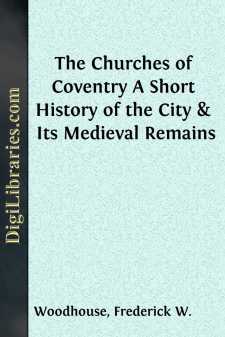Categories
- Antiques & Collectibles 13
- Architecture 36
- Art 48
- Bibles 22
- Biography & Autobiography 813
- Body, Mind & Spirit 142
- Business & Economics 28
- Children's Books 17
- Children's Fiction 14
- Computers 4
- Cooking 94
- Crafts & Hobbies 4
- Drama 346
- Education 46
- Family & Relationships 57
- Fiction 11829
- Games 19
- Gardening 17
- Health & Fitness 34
- History 1377
- House & Home 1
- Humor 147
- Juvenile Fiction 1873
- Juvenile Nonfiction 202
- Language Arts & Disciplines 88
- Law 16
- Literary Collections 686
- Literary Criticism 179
- Mathematics 13
- Medical 41
- Music 40
- Nature 179
- Non-Classifiable 1768
- Performing Arts 7
- Periodicals 1453
- Philosophy 64
- Photography 2
- Poetry 896
- Political Science 203
- Psychology 42
- Reference 154
- Religion 513
- Science 126
- Self-Help 84
- Social Science 81
- Sports & Recreation 34
- Study Aids 3
- Technology & Engineering 59
- Transportation 23
- Travel 463
- True Crime 29
The Churches of Coventry A Short History of the City & Its Medieval Remains
Description:
Excerpt
CHURCHES OF COVENTRY
MONASTERY AND CITY
The opening words of Sir William Dugdale's account of Coventry assert that it is a city "remarkable for antiquity, charters, rights and privileges, and favours shown by monarchs." Though this handbook is primarily concerned with a feature of the city he does not here mention—its magnificent buildings—the history of these is bound up with that of the city. The connection of its great parish churches with the everyday life of the people, though commonly on a narrower stage, is more intimate than is that of a cathedral or an abbey church, but it is to be remembered that without its Monastery Coventry might never have been more than a village or small market town.
We cannot expect the records of a parish church to be as full and complete as those of a cathedral, always in touch through its bishops with the political life of the country and enjoying the services of numerous officials; or as those of a monastery, with its leisured chroniclers ever patiently recording the annals of their house, the doings of its abbots, the dealings of their house with mother church and the outside world, and all its internal life and affairs. In the case of Coventry, the unusual fulness of its city archives, the accounts and records of its guilds and companies, and the close connection of these with the church supplies us with a larger body of information than is often at the disposal of the historian of a parish church. As therefore, in narrating the story of a cathedral some account of the Diocese and its Bishops has been given, so, before describing the churches of Coventry, we shall give in outline the history of the city which for 700 years gave its name to a bishop and of the great monastery whose church was for 400 years his seat.
Though Dugdale says that it is remarkable for antiquity, Coventry as a city has no early history comparable with that of such places as York, Canterbury, Exeter, or Colchester, while its modern history is mainly a record of fluctuating trade and the rise and decline of new industries. But through all its Mediæval period, from the eleventh century down to the Reformation, with an expiring flicker of energy in the seventeenth, there is no lack of life and colour, and its story touches every side of the national life, political, religious, and domestic. The only evidence of extreme antiquity produced by Dugdale is the suffix of its name, for "tre is British, and signifieth the same that villa in Latin doth;" while the first part may be derived from the convent or from a supposed ancient name, Cune, for the Sherborne brook.
The first date we have is 1016, when Canute invaded Mercia, burning and laying waste its towns and settlements, including a house of nuns at Coventry founded by the Virgin St. Osburg in 670, and ruled over by her.
But there is no sure starting-point until the foundation of the monastery by Earl Leofric and the Countess Godiva, the church being dedicated by Edsi, Archbishop of Canterbury, in honour of God, the Virgin Mary, St....


